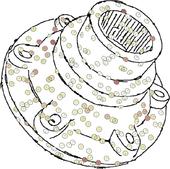Highlight
The artist in the computer
Achievement/Results
Rutgers researchers Doug DeCarlo (Computer Science) and Manish Singh (Psychology), funded by a grant from NSF’s Division of Computing and Communication Foundations and working in collaboration with colleagues at Princeton, have discovered ways of improving the ability of computer-generated line drawings to accurately depict three-dimensional shape. Teaching computers how to craft line drawings has proven to be a significant challenge: existing computer algorithms do not achieve the consistency evident in the drawings made by human artists. Progress in developing algorithms requires a model of how the drawings are perceived, along with perceptual experiments that measure the appearance of the shapes to human observers.
With Kevin Sanik, a trainee in Perceptual Science supported by NSF’s Integrative Graduate Education and Research Teaching program, DeCarlo, Singh and colleagues carried out a perceptual study of line drawings containing different types of lines, such as occluding contours, suggestive contours, ridges, valleys, and apparent ridges. Line drawings by artists were also studied. The research team used the psychophysical technique of adjusting “gauge figures” over various regions of a line drawing to probe viewers about how they perceive different shapes. Gauge figures are lines that resemble a thumb tack sitting upright on a surface: when properly adjusted by the viewer, the gauge figure appears to be lying flat, with the needle pointing outward and perpendicular to the surface.
The results of the experiments showed that while line drawings did not always produce the same three-dimensional percepts as photorealistic depictions, a combination of contour cues could lead to reliable percepts of three-dimensionality and shape. This work informs the design of useful and aesthetically pleasing graphical displays and visualizations that benefit from a line drawing style to overlay or clarify information.
Address Goals
The past decade has seen a proliferation of perceptual technologies, from automated systems that recognize faces, voices or 3D scenes, to dynamic multimodal interfaces and realistic virtual environments that enrich our communication with computers and with each other. It is now widely recognized that for these developments to succeed, it is imperative that they be based on firm knowledge and theories of human perceptual function. This activity shows the importance and value of developing novel perceptual graphical interfaces based on theories of human perceptual function. Often the most effective computer-generated images are not literal depictions of a scene, but rather, meaningful abstractions that convey essential information in a way that is readily understood.
A developing field within computer graphics consists of attempts to create usable images that are easy to understand because their structure and design is inherently compatible with the way the human perceptual system perceives and extracts meaning from a scene over space and time. Examples are found in the generation of assembly instructions, line drawings of 3-dimensional objects, and artistic rendering of natural scenes. These efforts depend on incorporating models of human perceptual analysis into the rules governing the design. The activity described in the highlight shows that advances in the understanding of how people perceive three-dimensionality in shape has motivated and guided new geometric and computational methods to create meaningful depictions of shapes that can be understood and manipulated by human perceivers.






